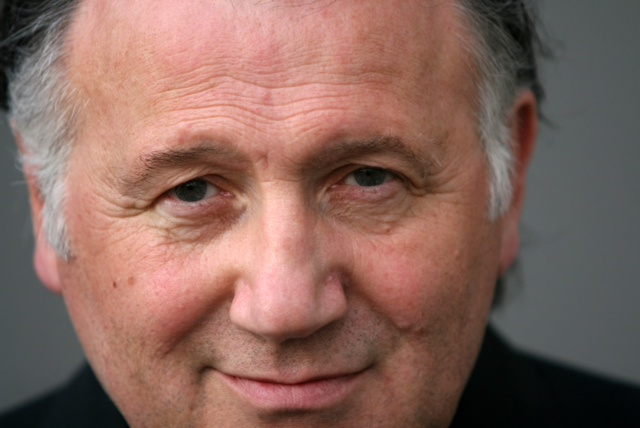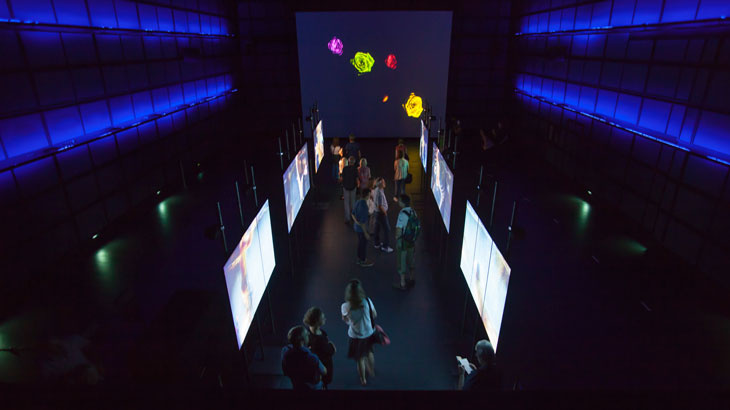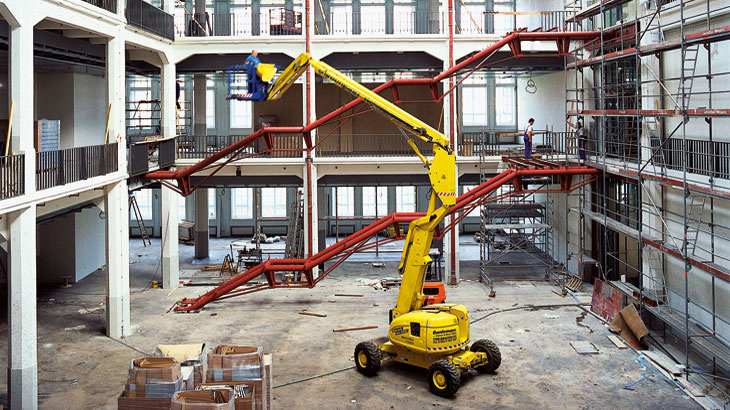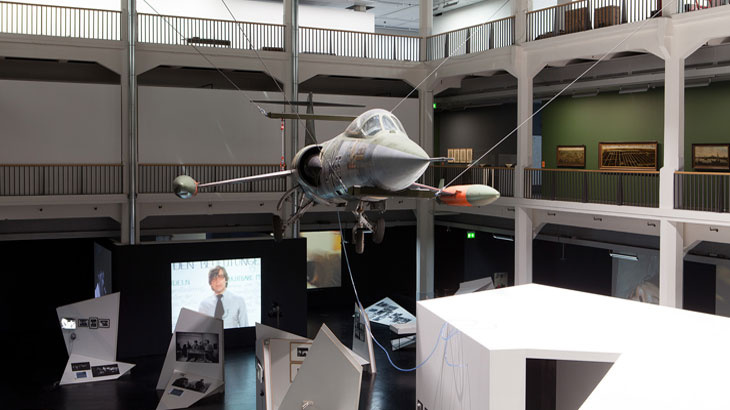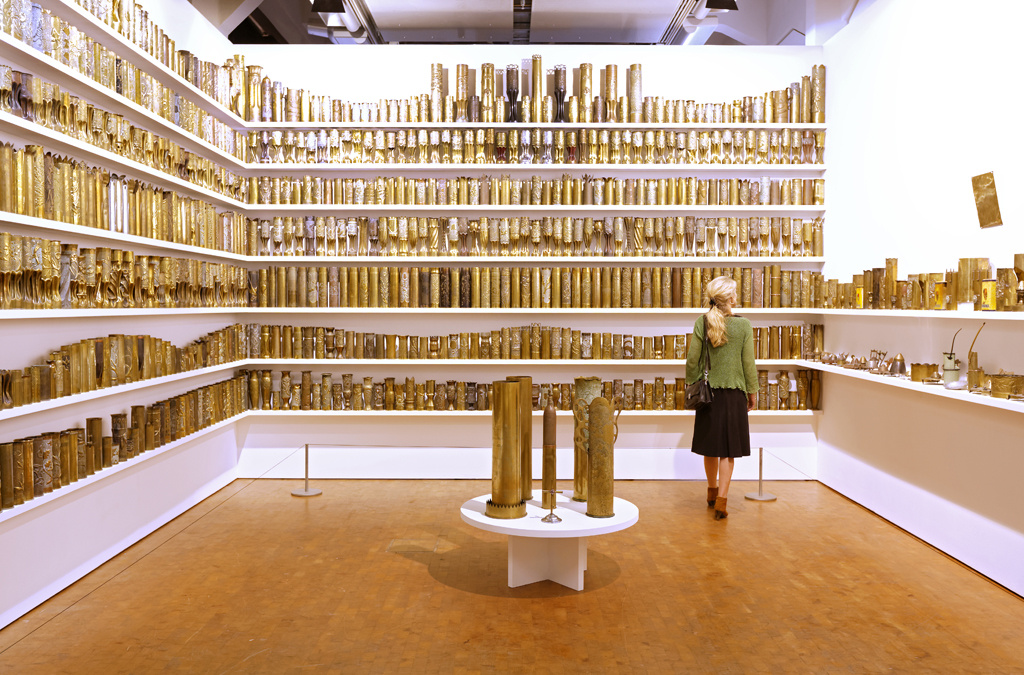25 Years ZKM: A Performative Museum of Time-based Arts
The ZKM was founded twenty-five years ago, in 1989. It took up permanent residence in the vast hall construction of the Industriewerke Karlsruhe-Augsburg, a former munitions factory. Now, on the occasion of the anniversary of its founding, one may well ask why the ZKM was established and to what historical events at the end of the 1980s this founding is indebted.
In my view, the ideas for the ZKM emerged following the revolutions that erupted in 1960s: the political and social revolutions, the artistic and technical revolution, the feminist movement, the sexual revolution and the rock and pop movement. When asking, what were the most important elements in the artistic and technical revolutions of the 1960s, the answer is simply this: the introduction of Action Art and the rise of the new Media.
In the first half of the twentieth-century, the European avant-gardes broke with art’s classical mission of representing reality by means of point, line, surface, color, volume, etc. This resulted, on the one hand (since Kasimir Malewitsch), in the self-portrayal of the means of representation, from geometric abstraction to Informel. On the other hand, (since Marcel Duchamp), this led to the self-portrayal of the objects; the representation of reality was substituted by reality itself, from readymades and surrealist objets trouvés through to assemblages and furniture sculptures. The art of objects led to a duplication of reality. From landscape painting emerged Land Art, painted, natural light gave rise to real, artificial light, and human portrait art evolved into Body Art. Real objects became the medium of real action in space and time. Thus, the neo-avant-gardes of the second half of the twentieth century introduced to art both action and media. Both transformations in the concept of art reciprocally condition and influence one another.
For thousands of years, the carrier medium of the image was classical painting, panel painting and mural painting. Following the invention of photography around 1840, further technical carrier image media appeared, such as film, video, computer, all of which were to change the concept of the image, from moving image through to animated image, and from virtual through to interactive image. Consequently, from classical panel painting there emerged the new images of media technology, but also the new forms of action.
From painting as a pure, time-based art, there developed a time-based activity around 1950. Hans Namuth’s photography and film on Jackson Pollock showed the painter in the act of painting. The action of painting then became as important as the product of painting itself. Hence, one also referred to Action Painting. By way of the canvass placed on the floor (for the Dripping of the paint), with Pollock, the vertical panel painting then became the arena of action. Via photography and film the act of painting became a performance, an Action before the audience. With the act of creation and design, Georges Mathieu advanced the influence of observation media to “show painting”, and painted on stage before an actual public (in 1956 he created a large-format panel painting measuring 4 × 12 meters at the Sarah-Bernhardt Theater, Paris before a 2000-strong audience). In a combination of Pollock and Mathieu, Yves Klein used real bodies as brushes, likewise before an audience, in 1960: naked female bodies would begin by rolling around on the surface of the arena before Klein proceeded to “paint” on the vertical canvass with their body impressions. Consequently, painting was to evolve in a three-step transformation – “action on canvas, action in front of the canvas, action without canvass” (P. W.), namely, from pure image and representational art to an augmented Action Art and Performance. In this way, painting had already begun to initiate and consummate a performative turn.
Action forms also arose from poetry, music and sculpture. Poetic, pictorial or sculptural actions, rather than aesthetic objects, dissolved the boundaries between time-based and space-based art, between performing and fine art, together with the separation of art and life. The concepts of art and work expanded. A panorama of Expanded Arts (George Maciunas, Expanded Arts Diagram, 1966) appeared in New York. In Europe Laszlo Glozer coined the term “Ausstieg aus dem Bild” [Stepping Out of the Picture] (Westkunst- Zeitgenössische Kunst seit 1939, Cologne, 1981).
Soon, Action Art began to cease limiting itself solely to the artist’s performance and was extended to encompass audience participation. Audience interactivity and participation – of the viewer, and visitor during Actions and demonstrations, both in the museum and on the street became an important instrument of artistic and social rebellion. Such Actions were supported by the New Media. Art expanded into all areas by way by way of new materials, New Media and new methods. Media such as photography, film, video and computer, however, not only played a documentary role; they not only constituted part of the expanded concept of the image but, from the 1960s and, with increasing intensity from 1990s on, also adopted a key role in the transformation of the dual concept of work and art.
It became apparent following the rise of the new information and communications technologies, when film and video, television and computer could be utilized for artistic purposes for the first time, that science and art share common tools. In view of these revolutionary developments in art, this “breakthrough and transformation in the Arts” (an important conference from March 10-13, 1988, in preparation for the founding of the ZKM was entitled Die Künste im Aufbruch [The Transformation of the Arts]), initial ideas began to emerge for the founding of the ZKM by far-sighted planers in the city of Karlsruhe.
Located in Karlsruhe, the university, with its history since Heinrich Hertz (the experimental proof for the existence of electromagnetic waves from 1886 to 1888), and one of the first faculties for computer science, was a driving force in this development. Scientists, artists, intellectuals and politicians in Karlsruhe anticipated the reciprocal influence of the new arts and society and, with the founding of a center for art and media technology, sought to provide artists with the possibility of creating works with the new media, and to offer the public possibilities for understanding the social effects of this development. One was still on uncertain terrain; the New Media had not yet reached the mainstream, while mobile telephones for all, and the public Internet were all still a long way off. For the forward-thinking founders of the ZKM, the Center for Art and Media was to be committed to the future of art and media. It was to be a seismograph of this future and, through the arts, allow the public to participate in the rapid developments of the New Media and their artistic-critical reflections.
On the occasion of the 25th anniversary, the idea arose to once again present the central conceptions informing the ZKM’s foundation, but this time by way of artists. With the exhibition Beuys Brock Vostell (May 24 - November 9, 2014) we show the three key representatives of Action Art in Germany, who exhibit programmatic agreement and thus frequently appeared together. The Festival der Neuen Kunst [The Festival of New Art], in Aachen, on July 20, 1964, the live broadcast Joseph Beuys: Fluxus Demonstration / Bazon Brock: Agit Pop / Wolf Vostell: Dé-coll/age Happening, by the Zweiten Deutschen Fernsehens [Second German Television Channel] for the series Die Drehscheibe [The Turntable] (1964), and the so-called 24 Stunden Happening [Twenty-Four-Hour Happening] at Galerie Parnass, in Wuppertal (1965), may be cited here as examples. Each in their own way, the three artists learnt their own lessons through their experiences of war, Holocaust and totalitarian systems: firstly, teaching itself was redefined. The lesson became performance art with objects of enlightenment and teaching at the center of which was education and enlightenment, acting and agitating, discussion and demonstration. Here, they drew on European traditions, such as Enlightenment, Protestantism, Idealism or Romanticism. A substantial amount of photographic and film material was publically exhibited for the first time. Important works were reconstructed, re-enacted or recreated.
In the exhibition Claus Bremer: mitspiel. theater und poesie [Participation. Theater and Poetry]1949−1994 (July 5–October 5, 2014) we also show the way in which the idea of participation gains currency at the same time as art in theater, in other words, audience participation. At the same time as open form in art, Claus Bremer began devising new theater playing techniques from around 1958. “The author calls on the actors to play along. By playing along, the actors invite the audience to participate.” (Claus Bremer, versuche mit festgelegten und nicht festgelegten aufführungen, [Experiments with Specified and Non-specified Performances] 1963.) With public participation in art, each of the artists cited above prepared the ground for civic participation in politics.
What Beuys, Brock and Vostell embody in Germany is personified by Jean-Jacques Lebel in France. In his paintings, collages and assemblages, he advanced in Nouveau Réalisme. In over sixty Happenings since 1960 Lebel extended the spectrum of free expression in painting and poetry in Action Art. Similarly, he updated the concept of image in his film and video installation.
Of particular relevance in this exhibition is the installation of projectile cases entitled Le cénotaphe dédié aux poilus bricoleurs anonymes de la Première Guerre mondiale (since 1958), half of which originate from the former Deutschen Waffen und Munitionsfabrik AG, the present-day ZKM, and which now, a hundred years later, return to the ZKM as a work of art. In other words, while in the trenches, the soldiers, as amateur artists, would fashion works of art from spent grenades and projectiles. As an activist Lebel also played an essential role in May 1968, and was member in a number of revolutionary groups. He is an important poet, and thus a friend of the representatives of the Beat Generation, from William S. Burroughs to Allen Ginsberg, whose works he had translated. He curated the exhibition Beat Generation / Allen Ginsberg, shown at the ZKM in 2013.
For the aspect of media art we have selected the most important representatives of American film art, one of Lebel’s friends. Jonas Mekas (Jonas Mekas. 365 Day Project, July 26 – November 9, 2014) has been one of the central figures of independent film since the 1960s. Without him American avant-garde film would not have existed – not only because of his films, but also because of his influential critiques, published for decades in the journal Village Voice and the journal he founded in 1954 called Film Culture, as well as the Film Makers Cooperative he likewise founded in 1962, and which went on to become the model for various imitations worldwide. He founded the institution Anthology Film Archives in 1970. Without Mekas there would have been no independent American film as we know it. Without this American “Underground Film” the global movement of avant-garde film would not have existed in its present manifestations. For this reason, we show Birth of a Nation from 1997, which brings together all important personalities in avant-garde film, as well as the installation of his dairy, which covers a period lasting for over a year, entitled 365 Day Project, from 2007.
With Lynn Hershman (CIVIC RADAR. Lynn Hershman Leeson – the Retrospective, December 13, 2014 – March 29, 2015), this autumn we present the most important representative of the feminist revolution who, with her photomontages , feature films, (video) installations, Internet projects and numerous media performances, has made decisive contributions to media art. As you can see, during this 25th anniversary year of the ZKM we take you back to the origins of the ZKM, namely, to those eras of artistic, technical and social revolution to which the foundation of the ZKM is indebted. While the ZKM has meanwhile become an institute that enjoys worldwide recognition, it continues to be a part of the revolutions to which it owes its beginnings – consider our exhibition global aCtIVIsm (December 14, 2013–March 30, 2014).
Related Tags
News Category
- take a look… behind the scenes of ZKM
